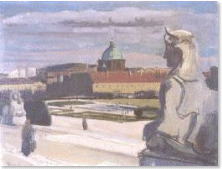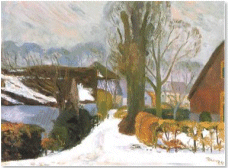|
||||
 View of Belvedere Park, Vienna oil on canvas, 1937, Private Collection (click to enlarge)
|
A particularly gifted youth, born in 1899 of a Viennese
Jugendstil city architect and mother from a rural, land-owning family in Austrian Upper
Silesia, Alfred attended the "Kunstgewerbeschule" in Vienna before being
admitted, in 1918, into the famous Vienna Academy of Arts. In 1926, having already exhibited with the "Sezession" art movement, he graduated with the prestigious "Prix de Rome". This achievement launched Krenz on his travels, first to Italy, then throughout Europe. In Paris he became an admirer of Cézanne, and worked for a while in the studio of Amédée Ozenfant. It was in 1928, when staying with a friend in Geneva, Switzerland, that he met his future wife, a Dutch girl from an old Curaçao family. In 1932 they married in Paris and settled in Vienna, just as Nazi Germany was preparing to engulf the rest of Europe. Immediately after the "Anschluss", the family left for Holland, only to be overtaken by the German invasion in 1940. During these years Krenz nevertheless managed to produce some fine work, and take part in exhibitions, taking his place in Dutch art circles. Some of his most typical, brooding landscapes stem from that period. In 1949 the family, grown then by five children, weary from their wartime experiences, left for South Africa. For Krenz, it was a new world, full of light and colour, which gave him fresh inspiration. In Cape Town he launched his own art school, which attracted not only young students, but also pupils from all walks of life. He held many one-man shows throughout the country, and participated in numerous group exhibitions. His landscapes and still lifes, but especially his masterly portraits, made a name for himself. Unfortunately, the estrangement from his wife, clashes with fellow artists and the local art establishment, and his own unbending nature overshadowed his later years. In October 1980 when on his way to a concert, he died of a heart attack, a disillusioned man.
|
|||

